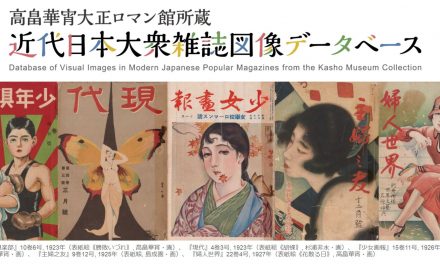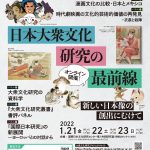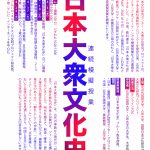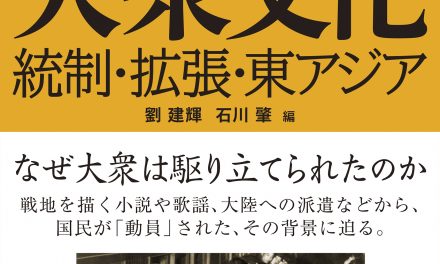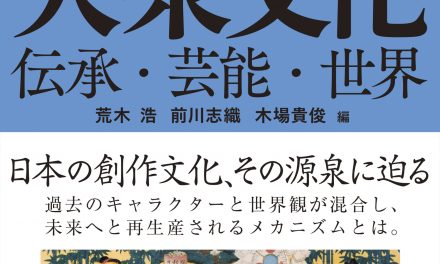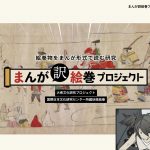
International Research Center for Japanese Studies
Historical and International Research into Popular Culture to Pursue New Images of Japan
Purpose
The Japanese Popular Culture Research Project, a transdisciplinary project of the NIHU Third Mid-Term Plan (FY2016–2021), facilitates historical and international research into popular culture with the aim of gaining a comprehensive, structural understanding of Japanese culture as a whole. The project will contribute to creating new images of Japan and new perspectives on Japanese culture. “Popular culture,” as defined under this project, is not limited to modern and contemporary mass culture but extends to pop culture, mass culture, subcultures. By studying popular culture in that broad sense of the term, and in a historical and international perspective, the project will seek an overall grasp of the basic elements and diversity of Japanese culture.
Expected Research Results
1. Implementation of International Collaborative Research on Popular Culture
Drawing on the wide array of research information resources and the wealth of achievements of team research accumulated at the International Research Center for Japanese Studies (Nichibunken), this project promotes international collaborative research on Japanese popular culture focusing on tales and legends, picture scrolls, yōkai and mystery stories, shunga and erotic books, rōkyoku narrative singing, film, fiction, Japan-related materials written in foreign languages or published overseas, visual culture, music, manga, anime, manners and customs, etc. A project promotion office has been established to take charge of managing and facilitating the research and the four teams organized under it, devoted to ancient/medieval, early modern, modern and contemporary times, respectively. The organization will be reviewed annually and the teams reorganized with the ultimate purpose of coordinating these teams as a single entity so that they can systematically carry out interdisciplinary, historical, and international collaborative research on popular culture. As the output of these endeavors, international workshops and research meetings take place every year at Nichibunken as well as at universities and research institutes in and outside Japan. Two international symposiums will also be held, at the mid-point and at the end of the project.
2. Creation of an Audio-Visual Library through Collection and Digitization of Popular Culture Material
A wide range of resources on popular culture will be collected, digitized, and entered into the database, and catalogs of publications in non-Japanese languages will also be stored in the database. Based on these resources, a media-mix-type library of audio-visual materials will be [has been] created to serve as a transmitter of information on popular culture.
3. Transmission of Research Results and Contribution to Educational Programs
As part of the results of this project, a four-volume series Kokusai Nihon Taishū-bunka Kenkyū Sōsho (tentative title; “International Research on Japanese Popular Culture Series”) will be published, and collected materials and digital resources will be exhibited and made available to the public. Presented in the form of an educational package, an historical textbook, tentatively titled Nihon taishū bunkashi [A History of Japanese Popular Culture], will be compiled that can be used as a guide to research on popular culture for university-level liberal arts courses in and outside Japan.
4. Re-building of Networks and Creation of an Advanced Hub for International Research
Interest in Japanese popular culture is growing worldwide and research on Japanese culture is being undertaken on a global scale. Given these circumstances, facilitating the three areas of effort outlined above calls for collaboration with universities in Japan and other countries and for providing assistance to scholars in Japanese studies. In the process of pursuing these aims, Nichibunken will build anew its international research network and establish an advanced hub for Japanese studies, in particular for popular culture research.
Research organization
The Ancient/Medieval Research Team
Focusing mainly on the times up to and including the medieval era, the “Ancient/Medieval Research Team” analyzes the social conditions of each phase of this historical span as well as the issues of what is “taishū” (popular) and what is fundamental to Japanese culture. By so doing, it hopes to gain a multifaceted understanding of the contemporary and international significance and context of the popular culture that formed the undercurrent of Japanese culture before the modern period. With the study of tales and legends and picture scrolls and related subjects as one vector and the perspectives of language culture, education in history, translation from classical/old Japanese or into foreign languages, and so on as another vector, the team seeks a comprehensive consideration of the classical world in the contemporary, popular-culture, and international contexts. To that end, working in tandem with the current Nichibunken team research project “Projecting Classicism: Visuality, Popularity, and Modernity,” this team will explore and create a new image of Japan from a broader perspective, working with the other three research teams of the Japanese Popular Culture Research Project.
(Leader: Araki Hiroshi, professor, International Research Center for Japanese Studies)
The Early-modern Research Team
The “Early-modern Research Team” deals with the period from the end of the medieval period through the Edo period (1603–1867). Focusing on the main topics of popular culture research conducted at Nichibunken such as yōkai and mystery stories, pictorial representations, and shunga and erotic books, this team considers not only early-modern popular culture but the incipient elements of modern Japanese culture while enriching and further developing the database.
(Leader: Komatsu Kazuhiko, director, International Research Center for Japanese Studies)
The Modern Research Team
The concept of “taishū” (the masses; populace, etc.) began to be used in the present-day sense of the word in the early years of the Shōwa era, the late 1920s. This coincided with a rapid spread of the mass media technology that had not been part of indigenous culture. Popular culture, taishū bunka, is therefore a product of the Shōwa era. Film evolved from silent movies to talkies, recording devices were electrified, radio began spreading from the middle- and upper-class families, news and advertisement photographs were printed in enormous quantities, “enbon” (“yen books”; cheap editions sold at the price of one yen) competed for the market, and magazines grew in circulation. Seen in the medium-term historical perspective, these changes were the consequence of modernization beginning in the Meiji era (1868–1912) and they are seen in a different guise even today. The “Modern Research Team” looks at the modernization of popular culture—including its formative years—and its historical features by focusing on visual images, rōkyoku narrative singing, film, sound, and so on. The team’s basic posture is to closely follow movements of small scenarios rather than trying to achieve broad-ranging theoretical results.
(Leader: Hosokawa Shūhei, professor, International Research Center for Japanese Studies)
The Contemporary Research Team
The “Contemporary Research Team” works to avoid the pitfalls of research on popular culture, the roots of which are difficult to trace. For example, it can be risky to argue for the continuity of culture based on the adaptations from classical culture seen in contemporary subcultures. It is also problematic to presume from the upsurge of interest in manga and anime overseas a revival of Japonisme-like thinking, or in similar fashion invent too-facile theories of traditional origins. On the other hand, the history of popular culture cannot possibly be divided into “modern” and “contemporary” by Japan’s 1945 defeat in World War II. The team strives to avoid the tendency to tacitly confine “contemporary” popular culture to manga and anime but to consistently pursue the historical aspects of the “expressive masses” and actions and institutions that expressed those collective movements. Light is also shed on the history of popular culture not as history peculiar to Japan but in the context contemporaneous with the history of East Asia and the world.
(Leader: Ōtsuka Eiji, professor, International Research Center for Japanese Studies)
Project Promotion Office
Nichibunken has established the project promotion office to integrate the research of the four teams. The office engages in activities to manage and facilitate popular culture research from an overall perspective.
Textbook production project team
In the attempt to obtain a perspective across the spectrum of research undertaken by the teams, the text production project team has been set up [within the Project Promotion Office] to facilitate the planning and compilation of the textbook tentatively titled Nihon taishū bunkashi [A History of Japanese Popular Culture], which can be used as a guide to popular culture research for university-level liberal arts courses in and outside Japan. As a means of preventing team or sub-team subdivision of the results of popular culture research, the textbook production project team serves as a hub for sharing the overall picture of research achievements and disseminating them widely.


